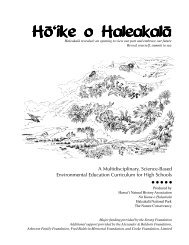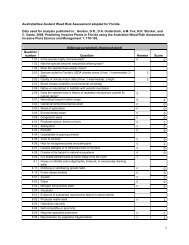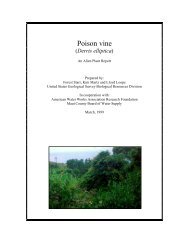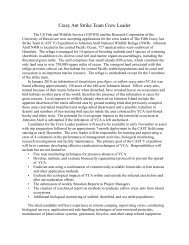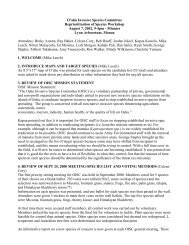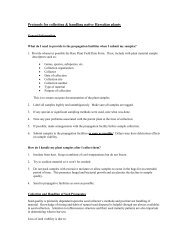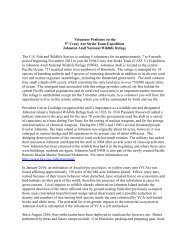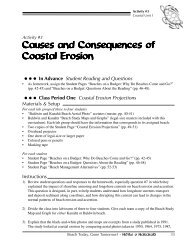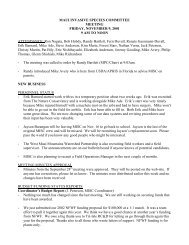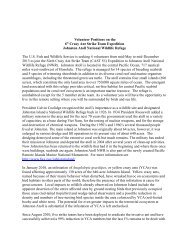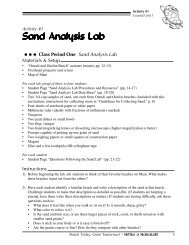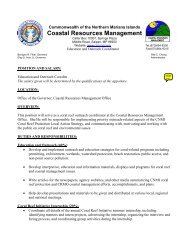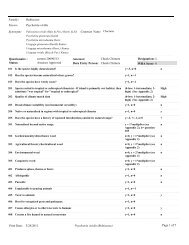Kiai i Na Moku o Maui Nui Winter 2010-2011 - Hawaiian ...
Kiai i Na Moku o Maui Nui Winter 2010-2011 - Hawaiian ...
Kiai i Na Moku o Maui Nui Winter 2010-2011 - Hawaiian ...
You also want an ePaper? Increase the reach of your titles
YUMPU automatically turns print PDFs into web optimized ePapers that Google loves.
-<br />
Kia‘i i <strong>Na</strong> <strong>Moku</strong> o <strong>Maui</strong> <strong>Nui</strong><br />
“Guarding the Islands of <strong>Maui</strong> County”<br />
Newsletter of the <strong>Maui</strong> Invasive Species Committee<br />
<strong>Winter</strong> <strong>2010</strong>-<strong>2011</strong><br />
Asking Albizia To Go<br />
By Shannon Wianecki<br />
MISC Editor and Curriculum Writer<br />
How does a two-person team<br />
control 850 invasive trees? If<br />
you’re MoMISC, you ask for<br />
permission first—from the landowner,<br />
the ancestors, and the trees themselves.<br />
When Lori Buchanan of the Moloka‘i/<br />
<strong>Maui</strong> Invasive Species Committee<br />
(MoMISC) learned that albizia trees<br />
were invading a steep gulch in Nā‘iwa,<br />
she started strategizing. <strong>Na</strong>tive to the<br />
Indonesian archipelago, albizia rapidly<br />
monopolizes disturbed mesic and wet<br />
forests in Hawai‘i, and can rise to over 120<br />
feet tall with wide, interlocking canopies.<br />
Because albizia<br />
trees fix nitrogen<br />
in the soil, they<br />
alter <strong>Hawaiian</strong><br />
forests to favor<br />
non-native<br />
plants.<br />
“It’s a step<br />
in restoring<br />
a whole<br />
genealogy.”<br />
The Nā‘iwa<br />
discovery was the only albizia population<br />
on Moloka‘i—making it a good candidate<br />
for eradication. But controlling the trees<br />
would be a huge project, requiring the<br />
cooperation of many stakeholders.<br />
First Buchanan approached the<br />
landowner, who granted access to<br />
the site. Land and air surveys revealed<br />
a fifteen-acre patch of mature trees,<br />
some with trunks measuring seven<br />
feet in circumference. Before rounding<br />
up extra hands to help with control work,<br />
Buchanan consulted kumu Mikiala Pescaia,<br />
who has genealogical ties to the area.<br />
“It’s a good idea to ask permission before you<br />
do anything,” says Buchanan. “Every place is<br />
sacred, or has some history, and so it’s always a<br />
good idea to consult the indigenous culture.<br />
“Nā‘iwa is makahiki and hula grounds. The crew<br />
needed to know why it’s special before working there.”<br />
Pescaia agreed to ask her ancestors to bless the project<br />
and to share the importance of the site’s numerous platforms<br />
and heiau with the crew. She explained how killing during the<br />
makahiki season would be inappropriate, since it was a time of<br />
peace and rest.<br />
“She took us to the edge of Kalaupapa and said, ‘This is where<br />
the spirits leap off,’” says Buchanan. “After that, the crew was hyped.<br />
See "Albizia" on page 4<br />
In this issue:<br />
• How to find a weed without touching ground<br />
• Two people, one island, and plenty invasive<br />
Species-a job for The Eradicators<br />
• The <strong>Na</strong>ture Conservancy on Moloka‘i<br />
• MISC's New Chairperson--Pat Bily<br />
• Dr. Miscellaneous goes Interisland
Message from the Manager<br />
"You can’t treat a thousand<br />
acres on your own.”<br />
By Teya Penniman<br />
MISC Manager<br />
is hana kūpono?<br />
What is <strong>Hawaiian</strong><br />
“What<br />
protocol? It’s right<br />
behavior, conducted at the right time.”<br />
These words by MoMISC coordinator<br />
Lori Buchanan captured the essence<br />
of the <strong>2010</strong> Hawai‘i Conservation<br />
Conference theme.<br />
Every summer, the Hawai‘i<br />
conservation community gathers<br />
to “talk story” about the work of<br />
protecting our natural resources –<br />
sharing strategies and successes. Over<br />
the last several years, conference<br />
organizers have sought to incorporate<br />
and celebrate <strong>Hawaiian</strong> culture as<br />
part of the annual meeting. The <strong>2010</strong><br />
theme focused on applying traditional<br />
and western knowledge systems to<br />
conservation work. Not sure what that<br />
means? Lucky for us, Buchanan helped<br />
bring that concept into focus.<br />
As you will learn in this newsletter,<br />
the Moloka‘i/<strong>Maui</strong> Invasive Species<br />
Committee (MoMISC) quietly manages<br />
to move mountains with what seems<br />
to be a sand bucket and hand trowel:<br />
their staff is small and they don’t ask for<br />
much. The articles about The <strong>Na</strong>ture<br />
Conservancy and albizia highlight<br />
the importance of partnerships and<br />
community support in getting the job<br />
done with such limited resources. But<br />
MoMISC is also tapping into a sense of<br />
place and respect for <strong>Hawaiian</strong> protocol<br />
to help ensure success.<br />
As Buchanan explained, “<strong>Hawaiian</strong>s<br />
come from the perspective that all<br />
living things have spirit.” Proper<br />
protocol includes asking for permission<br />
from the land and the ancestors of the<br />
land to conduct the work. It includes<br />
acknowledging the contributions<br />
that the plants have made to our<br />
environment, even if you are about to<br />
remove them, because “you go through<br />
cultural protocols with plants the same<br />
way you would with anything else.”<br />
Western knowledge still has its place,<br />
whether it’s mapping helicopter surveys<br />
across the East Moloka‘i watershed with<br />
a GPS unit or planning the logistics of<br />
removing a massive stand of albizia trees.<br />
But as Moloka‘i is showing, embracing<br />
the <strong>Hawaiian</strong> perspective while using<br />
Western techniques can be good for the<br />
project and good for the workers.<br />
And Buchanan’s take-home message<br />
for others working in conservation? “If<br />
there was a spiritual component that<br />
would make your project more effective,<br />
would you do it? Of course you would.<br />
Adding the cultural perspective of<br />
<strong>Hawaiian</strong> spirituality makes sense. You<br />
can’t treat a thousand acres on your own.”<br />
We invite you to read about MoMISC<br />
and learn why we are honored to have a<br />
close working relationship with our sister<br />
ISC on the island of Moloka‘i.•<br />
2<br />
Invasvie albizia were encroaching on this archeological site on Moloka‘i.
Kia‘i i <strong>Na</strong> <strong>Moku</strong><br />
o <strong>Maui</strong> <strong>Nui</strong><br />
"Guarding the Islands of <strong>Maui</strong><br />
County" is the official newsletter<br />
of the <strong>Maui</strong> Invasive Species<br />
Committee. To join our mailing<br />
list please call 573-6472 or email<br />
miscpr@hawaii.edu.<br />
Editors:<br />
Shannon Wianecki<br />
Teya Penniman<br />
Elizabeth Anderson<br />
Wendy Swee<br />
Lissa Fox, Design<br />
Contributors:<br />
Steven Ambagis<br />
Lissa Fox<br />
Brooke Mahnken<br />
Teya Penniman<br />
Wendy Swee<br />
Shannon Wianecki<br />
Adia White<br />
Ed Misaki, Moloka‘i program<br />
director for The <strong>Na</strong>ture<br />
Conservancy (TNC), loves<br />
showing off the island’s three preserves,<br />
each a showcase of unique endemic<br />
species. These lands were his training<br />
ground, and he enjoys seeing others<br />
realize what special examples of<br />
evolution <strong>Hawaiian</strong> plants and animals<br />
represent. But for conservation on<br />
Moloka‘i to truly succeed, he says,<br />
people must realize that community<br />
support offers more protection than<br />
even the goat-proof fences that encircle<br />
the island’s preserves.<br />
Founded in 1951, The <strong>Na</strong>ture<br />
Conservancy is a leading conservation<br />
organization working around the<br />
world to protect ecologically important<br />
lands and waters for nature and<br />
people. It established Kamakou, its first<br />
preserve on Moloka‘i, in 1982 with a<br />
conservation easement from Moloka‘i<br />
Ranch.<br />
Kamakou lies near the summit of the<br />
island’s highest mountain. Clouds and<br />
mist often signal a visitor’s proximity to<br />
the rain forest. The preserve sign, almost<br />
illegible for its lichen patina, marks the<br />
entrance to a lush world of exuberant<br />
Partners Pulling Together<br />
TNC Moloka‘i<br />
By Wendy Swee<br />
MISC Education/Outreach and Data Associate<br />
shrubs, prehistoric-looking ferns, and<br />
‘ōhi‘a trees bearing red, orange, and<br />
yellow blossoms. A boardwalk leads<br />
through Pēpē‘ōpae Bog, where sedges<br />
grow taller than miniature ‘ōhi‘a trees<br />
carrying full-size blooms.<br />
Pelekunu Preserve encompasses the<br />
highest sea cliffs in the world and a<br />
freshwater stream containing native<br />
aquatic animals, such as the famed<br />
‘o‘opu, gobies that climb sheer waterfalls<br />
with suction-cup-like pelvic fins.<br />
Mo‘omomi, the third preserve, added<br />
in 1988, contains more rare coastal<br />
species and intact sand dunes than<br />
any other place in the main <strong>Hawaiian</strong><br />
Islands.<br />
Misaki and the field staff began a<br />
program of “passive restoration” in the<br />
preserves—removing invasive species<br />
in hopes that native species recover on<br />
their own. By removing and mulching<br />
invasive kiawe trees at Mo‘omomi,<br />
they’ve seen native plants return in<br />
succession-first native grasses, and<br />
then a kaleidoscope of dune plants<br />
like the “star of Mo‘omomi,” the rare<br />
silvery ‘ena‘ena. Nest burrows for the<br />
native shearwater, ‘ua‘u kani, have also<br />
See "TNC" on page 8<br />
www.mauiisc.org<br />
miscpr@hawaii.edu<br />
P.O. Box 983<br />
Makawao, HI 96768<br />
The <strong>Maui</strong> Invasive Species<br />
Committee is a partnership of<br />
government, non-profit, and private<br />
organizations working to protect<br />
<strong>Maui</strong> County from the most harmful<br />
invasive plants and animals.<br />
Ed Misaki surveys the dune ecosystem at Mo‘omomi.<br />
3
How do you control 120' tall albizia?<br />
Field crews girdled the massive<br />
trunks with chainsaws and applied<br />
a small amount of herbicide.<br />
"Albizia" continued from page 1<br />
We knew we were going to sweat and<br />
work our butts off, but people would<br />
appreciate what we were trying to do. It<br />
put our work in a whole new light.<br />
“Mikiala sees all her cultural sites being<br />
taken over by invasive species. Our work<br />
is important to her, to her ancestors,<br />
and to future generations. It’s a step in<br />
restoring a whole genealogy.”<br />
Mikiala Pescaia asked her ancestors for<br />
permission before entering the work site.<br />
She outlined appropriate behavior for<br />
the crew to observe while working: no<br />
swearing, negative thoughts, smoking,<br />
or removing anything from the area.<br />
Then, says Buchanan, “She went to the<br />
edge of the gulch and said to the trees,<br />
‘You guys have to go. Thank you for<br />
what you’ve provided—oxygen, shade,<br />
etcetera, but you have to go. Lori and<br />
MoMISC are going to come and take<br />
you out.’”<br />
Actually, it was Lori, MoMISC, and<br />
a small army. Kamalani Pali, the other<br />
half of MoMISC, helped organize crews<br />
from The <strong>Na</strong>ture Conservancy, <strong>Maui</strong><br />
Invasive Species Committee, and U.S.<br />
Fish and Wildlife Service. John Neizman<br />
from the Department of Land and<br />
<strong>Na</strong>tural Resources assisted with clearing<br />
the access road. Two retired foresters<br />
volunteered to cut and treat trees. The<br />
U.S. Department of Agriculture Plant<br />
Materials Center donated ninety pounds<br />
of native kāwelu, ‘a‘ali‘i, and ‘āweoweo<br />
seed mix. Before controlling the trees,<br />
Pescaia and the crew spread the seeds<br />
throughout the site, to repopulate the<br />
forest with native plants and suppress<br />
albizia regrowth.<br />
Scientists and cultural advisors agreed<br />
that the best time to start work was the<br />
first week of March, after makahiki had<br />
passed. The crew girdled massive trunks,<br />
scraping the bark off with chainsaws to<br />
get to the heartwood and swabbing the<br />
cuts with small amounts of herbicide.<br />
Despite the heavy labor—three days<br />
of wielding chainsaws and rappelling<br />
to reach cliff-side trees—no one was<br />
injured.<br />
Local businesses pitched in, too.<br />
Moloka‘i Community Federal Credit<br />
Union and Ron Kimball of Kamehameha<br />
Schools helped feed the workers. Mac<br />
Poepoe and Kanohowailuku Helm,<br />
local fishermen who have published a<br />
<strong>Hawaiian</strong> moon calendar, gave a pau<br />
hana workshop on how to be a pono<br />
fisherman. Realtors Diane and Larry<br />
Swenson accommodated visiting crews<br />
in their roomy warehouse.<br />
A year later, only four of 850 albizia<br />
trees required re-treatment. The project<br />
brought together community members,<br />
field staff, and cultural practitioners.<br />
Work crews valued the opportunity<br />
to practice traditional protocols while<br />
working to free the island’s native<br />
forests from invasive pests. There’s no<br />
arguing that involving the community<br />
and asking for permission resulted in<br />
resounding success. The lessons learned<br />
during the albizia project will be applied<br />
to future control efforts on Moloka‘i and<br />
<strong>Maui</strong>.<br />
“So many components had to come<br />
together. Everybody had to be on board,”<br />
says Buchanan. “But that’s our job: to<br />
make it easy for people to help us.” •<br />
Some things are better not shared with our sister island.<br />
4
A View From Above<br />
New Science<br />
By Stephen Ambagis<br />
Owner, Resource Mapping Hawai‘i<br />
Resource Mapping Hawai‘i, a<br />
small company based on the Big<br />
Island, formed in response to the<br />
conservation community’s overwhelming<br />
demand for techniques to detect, map,<br />
and monitor invasive species over large<br />
landscapes. Agencies across the State, such<br />
as The <strong>Na</strong>ture Conservancy, U.S. Geological<br />
Survey, and Department of Land and<br />
<strong>Na</strong>tural Resources, identified the need to<br />
test data collection techniques for mapping<br />
a suite of ecosystem-changing weeds.<br />
Because many invasive species in Hawai‘i<br />
are widely distributed and the terrain is<br />
so inhospitable to human traffic, it was<br />
imperative to find a way to track their<br />
spread from above. Our early work focused<br />
on using satellite images. The results were<br />
inconclusive. Images taken from space cover<br />
large areas, but they are coarse; individual<br />
details are hard to distinguish. Our next<br />
approach was to collect aerial imagery.<br />
Taken from airplanes, these images cover<br />
smaller areas with higher resolution. There<br />
Australian tree fern as it appears in natural<br />
color aerial photography. Botanist recognize<br />
this invasive fern by its characteristic shape.<br />
"We can map and monitor<br />
large areas where 'boots on<br />
the ground' are difficult."<br />
are a number of different types of aerial<br />
imagery, but only some of them effectively<br />
map plant species. After several pilot<br />
projects and research around the state,<br />
we determined that the best approach for<br />
mapping species was a combination of<br />
ultra-high-resolution natural color data<br />
and hyperspectral data.<br />
Everyone knows what “natural color<br />
data” is—even if the term is unfamiliar—<br />
because we use it every day when taking<br />
snapshots of our kids or garden. It’s a<br />
simple reproduction of the light and<br />
colors we see in a frame.<br />
“Hyperspectral” is a word that<br />
is thrown around in remotesensing<br />
circles but is not clearly<br />
understood by most people.<br />
It refers to images that have a<br />
large amount of data stored on<br />
a per-pixel basis. They capture<br />
more color frequencies than are<br />
detectable by the human eye,<br />
essentially tripling our ability<br />
to “see” wavelengths, from 800<br />
nanometers to 2,400 nanometers.<br />
This technology allows us to<br />
investigate not just the shape<br />
and color but also the chemical<br />
properties of the objects in the<br />
frame. Originally developed for use in the<br />
mineral mining industry, hyperspectral<br />
images can reveal carbon, nitrogen, and<br />
water content.<br />
Analyzing hyperspectral data takes<br />
years of experience, expensive software,<br />
and lots of research. Each plant or<br />
mineral may have a unique spectral<br />
signature. Identifying the signature<br />
you’re interested in and separating it<br />
from the others in the image is a complex<br />
process. In comparison, almost anyone<br />
with some botanical knowledge and a<br />
basic understanding of computers can<br />
learn to analyze natural color data.<br />
It’s important to realize that neither<br />
imaging technique can map all species<br />
all the time. Invasive strawberry guava<br />
is difficult to distinguish from native<br />
forest plants, even at high resolution;<br />
this species is more easily mapped using<br />
hyperspectral analysis. Australian tree<br />
fern is the opposite; its spectral signature<br />
is almost identical to that of the native<br />
hapu‘u fern, but botanists can tell the two<br />
apart using natural color data.<br />
For the time being, hyperspectral data<br />
is still expensive to collect and difficult<br />
to analyze. As the technology improves<br />
and becomes more financially attainable<br />
See "Imagery" on page 8<br />
5
Top Six MoMISC<br />
Targets<br />
The<br />
Autralian Tree Fern (Cyathea cooperi)<br />
• <strong>Na</strong>tive range: Australia<br />
• Aggressively outcompetes<br />
<strong>Hawaiian</strong> plants in forest<br />
understory. Wind-spread spores<br />
can travel over seven miles from<br />
parent plant.<br />
• Widespread on main <strong>Hawaiian</strong><br />
Islands except for Moloka‘i, Lāna‘i<br />
and Kaho‘olawe<br />
• On Moloka‘i, isolated<br />
introductions have not yet naturalized. Plants at<br />
private residences were removed and replaced<br />
with native hapu‘u ferns.<br />
Rubber vine<br />
(Cryptostegia madagascariensis)<br />
• <strong>Na</strong>tive range: Madagascar<br />
• Smothers other plants. Poisonous. May<br />
interfere with heart function and cause<br />
intestinal upset. Milky sap can cause<br />
burning rashes. When dry, sap can cause<br />
coughing, nose swelling, and eyelid blisters.<br />
• Present on main <strong>Hawaiian</strong> Islands except<br />
Kaho‘olawe.<br />
• On Moloka‘i,<br />
several infestations<br />
have been controlled<br />
and sites are being<br />
monitored for<br />
seedlings.<br />
Fireweed (Senecio madagascariensis)<br />
• <strong>Na</strong>tive range: Madagascar<br />
• Invades pastures, disturbed areas and<br />
roadsides. Produces up to 30,000 easily spread<br />
seeds. Toxic to<br />
livestock.<br />
• Invading <strong>Maui</strong> and<br />
Hawai‘i Island,<br />
found on other<br />
islands. Priority<br />
target on Kaua‘i<br />
and O‘ahu.<br />
• On Moloka‘i,<br />
found in isolated<br />
areas.<br />
6<br />
By Shannon Wianecki<br />
MISC Editor and Curriculum Writer<br />
The Moloka‘i/<strong>Maui</strong> Invasive Species Committee has an impressive<br />
reach. Tackling everything from fifty-foot-tall trees to stinging<br />
jellyfish, the two-person MoMISC team successfully prevents<br />
scores of invasive species from overrunning an entire island. The secret,<br />
according to MoMISC dynamo Lori Buchanan, is making invasive species<br />
control everyone’s kuleana.<br />
Empowering Moloka‘i residents with tools to mālama i ka ‘āina, care<br />
for the land, MoMISC distributes fire ant detection kits at fairs, gives<br />
weed workshops for Monsanto irrigation and spray crews, and negotiates<br />
with ranchers to prevent the importation of cattle from fireweed-infested<br />
pastures. When Buchanan and fellow MoMISC staffer Kamalani Pali<br />
approach homeowners growing Australian tree fern, they offer to replace<br />
the foreign pest with native hapu‘u ferns.<br />
Species that are pervasive problems on other islands are being eradicated<br />
on Moloka‘i: fountain grass, pampas grass, and gorse.<br />
“We’re careful about which targets we choose to eradicate,” says<br />
Buchanan. “Once we take on a target, we’re very serious. We’re in for the<br />
long haul. We’re going to eradicate the seedbank.”<br />
MoMISC also collaborates with the Division of Forestry and Wildlife<br />
(DOFAW) to control species such as wood rose, palm grass, and New<br />
Zealand flax that are too widespread to be eradicated but threaten<br />
wilderness areas. “Wood rose is distributed throughout the island. I<br />
wouldn’t take it on as a target for eradication,” says Buchanan. “But I will
“The secret is making invasive species<br />
control everyone’s kuleana.”<br />
control a population growing at 2,500-foot elevation on the border of a<br />
pristine native forest.”<br />
In Hālawa Valley, Barbados gooseberry, a nasty arboreal cactus, is<br />
too entrenched for MoMISC’s limited staff to effectively control, says<br />
Buchanan. “Instead, we go to the organizations that are doing kalo<br />
restoration there and say, ‘You know, you have some issues in this valley.<br />
We can train you and provide you with maps, GPS, and methodology.’<br />
We share our expertise on methods that are effective.”<br />
Rather than waiting for pests to become problems, MoMISC is always<br />
on alert for incipient invaders.<br />
“Cattle was brought in from <strong>Maui</strong> and distributed to ranches all<br />
around the island. Now we’re seeing fireweed pop up,” says Buchanan.<br />
“We’re trying to nip that in the bud.”<br />
When island ranchers planned to import another 700 head of<br />
cattle from gorse- and fireweed-infested pastures on <strong>Maui</strong>, MoMISC<br />
intervened. The ranchers agreed not to bring in cattle at this time and<br />
MoMISC offered to develop a protocol for importing livestock without<br />
unwanted hitchhikers.<br />
At present, Moloka‘i is miconia-free and they plan to keep it that way.<br />
Starting in 2005, she and Pali strapped on helicopter helmets to survey<br />
the island’s forests from above for miconia’s telltale purple leaves. They<br />
targeted areas that would most likely be infested with seeds carried by<br />
birds first, then worked their way across the island. “It’s a cycle,” says<br />
Buchanan. “We’ll go back now to where we started. This year we have 14<br />
hours of flight time and a pretty nice map. We keep on looking.”<br />
Nestled within The <strong>Na</strong>ture Conservancy’s Moloka‘i headquarters,<br />
MoMISC operates as a mobile, responsive extension of the island’s other<br />
conservation agencies.<br />
“MoMISC is the blanket organization, because we have no boundaries,”<br />
says Buchanan. The Conservancy, <strong>Na</strong>tional Park Service, <strong>Na</strong>tural Area<br />
Reserve System, and DOFAW are bound to specific locations under<br />
their jurisdiction, while MoMISC “can go east to west, north to south. It<br />
makes us ideal.<br />
“Of course we don’t go hog wild. We’re only controlling jellyfish in<br />
the area where kids swim. We did mangrove because it’s breaking up<br />
the sea wall at the wharf. If it’s a clear threat to human health and the<br />
environment, we’ll respond. That’s our mission: to respond rapidly and<br />
do whatever needs to be done.”<br />
In the absence of a full-time Hawai‘i Department of Agriculture<br />
representative on Moloka‘i, MoMISC is often summoned to identify<br />
unusual species that turn up on the island. “We’ve been called for<br />
everything from spiders to glowing, floating things on the water,” says<br />
Buchanan.<br />
MoMISC also keeps sharp lookout for the light brown apple moth<br />
and stinging nettle caterpillar—two agricultural pests that haven’t yet<br />
been sighted on Moloka‘i. The crew assists Chevy Levasa of the U.S.<br />
Department of Agriculture in monitoring traps and collecting survey<br />
data that will expedite control efforts should these pests arrive.<br />
“Lori and I work as a team,” says Levasa. “Considering that we don’t<br />
have a state inspector, I think we do a really good job. We get the word<br />
out. Together we earn the trust of the community, by being available.”<br />
“We’re all working for the same goal,” says Buchanan. “Keeping our<br />
native forests pristine.”•<br />
Tumbleweed (Salsola kali)<br />
• <strong>Na</strong>tive range: Asia<br />
• Highly invasive in open, disturbed landscapes.<br />
Mature plants produce up to 200,000 tiny<br />
seeds. Public safety hazard; windstorms blow<br />
tumbleweeds into oncoming traffic. Rolling,<br />
burning tumbleweeds can spread wildfire.<br />
• Expanding in Upcountry <strong>Maui</strong>. Found on<br />
O‘ahu, and<br />
Hawai‘i Island.<br />
• On Moloka‘i a<br />
single infestation<br />
was eradicated.<br />
Little fire ant (Wasmannia auropunctata)<br />
• <strong>Na</strong>tive range: Central<br />
and South America<br />
• Infests houses and farms,<br />
damaging crops and<br />
stinging workers.<br />
Disrupts the balance of<br />
native ecosystems.<br />
Promotes plant pests<br />
such as aphids. Blinds pets and other animals.<br />
• Infesting the windward side of Hawai‘i Island;<br />
isolated nests found and controlled on Kaua‘i<br />
and <strong>Maui</strong>. Alos a MISC target.<br />
• Not yet found on Moloka‘i, Early detection<br />
efforts underway.<br />
Coqui frog (Eleutherodactylus coqui)<br />
• <strong>Na</strong>tive range:<br />
Puerto Rico<br />
• Loud, incessant<br />
call from dusk<br />
until dawn.<br />
Adverse<br />
economic<br />
impacts on tourism. Decreased export plant<br />
sales and decreased property values. Eats huge<br />
quantities of insects disrupting ecosystem<br />
balance. Potential food source for snakes.<br />
• Widespread on Hawai‘i Island; limited<br />
populations <strong>Maui</strong>, Kaua‘i, and O‘ahu. Also a<br />
MISC target.<br />
• In 2002 and <strong>2010</strong> lone coquis were reported<br />
and subsequently captured by MoMISC. Early<br />
detection efforts are underway.<br />
7
The rare silvery ‘ena‘ena is one of the<br />
native dune plants that has returned<br />
following the removal of invasive<br />
kiawe at Mo‘omomi.<br />
"TNC" continued from page 3<br />
multiplied as the kiawe staging area for<br />
feral cats disappeared, and local trucks<br />
now stay on the track marked by TNC<br />
across the dunes.<br />
By building fences and controlling feral<br />
ungulates in the other preserves, TNC<br />
has succeeded not only in improving<br />
forest integrity but also in slowing<br />
the sedimentation rate impacting the<br />
island’s coral reefs—improving fishing<br />
sites for the community at the same time.<br />
In addition to resource management,<br />
TNC leads public hikes and student<br />
field trips in the preserves and places<br />
high importance on training docents<br />
and volunteers, including them in the<br />
organization’s work.<br />
Desiring the ability to address invasive<br />
threats beyond the confines of their<br />
preserves, the TNC weed managers<br />
led the call in the early 1990s for the<br />
Moloka‘i branch of the <strong>Maui</strong> Invasive<br />
Species Committee.<br />
8<br />
Ed Misaki, Lori Buchanan, and Kama Pali<br />
The Conservancy lent the fledgling<br />
MoMISC office space, transportation, a<br />
computer, and its first employee—Lori<br />
Buchanan, who credits TNC for<br />
sparking her interest in native <strong>Hawaiian</strong><br />
species. When she accompanied her son<br />
on a field trip to the Kamakou Preserve,<br />
she says, “The docent from Canada told<br />
me which plants I was looking at and<br />
what was going on with my mountain. It<br />
hit me that I should know this already,<br />
and I didn’t.” So she signed up for TNC’s<br />
docent training program, logging over<br />
100 hours before she was tapped to lead<br />
MoMISC.<br />
TNC continues to provide MoMISC<br />
with office space and manpower when<br />
needed, especially for suppression<br />
of large targets like albizia. The sister<br />
organizations divide responsibilities to<br />
reach mutual goals—such as solidifying<br />
community support. Misaki claims this<br />
is especially crucial on a small island like<br />
Moloka‘i: “It’s about working with your<br />
community for long-term support. You<br />
don’t see results right away—it’s about<br />
engaging, informing, making them part<br />
of your organization.”<br />
To that end, TNC relies on a<br />
community advisory council, holds<br />
ahupua‘a meetings to address local<br />
concerns, hires locally, and sponsors<br />
Moloka‘i Earth Day, attracting more<br />
than 1,000 of the island’s 7,000 residents<br />
to learn about their roles in preserving<br />
natural and cultural resources.<br />
Misaki acknowledges the importance<br />
of community support and the aid of<br />
partners like MoMISC in carrying out<br />
TNC’s mission: “The ecosystem doesn’t<br />
have property boundaries.” •<br />
"Imagery" continued from page 5<br />
for conservation managers, the use of<br />
hyperspectral data will become more<br />
widespread. In the meantime, we’re<br />
focusing on ultra-high-resolution<br />
natural color imagery to manually<br />
identify the plants of interest.<br />
On Moloka‘i, we will assist The<br />
<strong>Na</strong>ture Conservancy and MoMISC in<br />
searching over 6,000 acres for invasive<br />
Australian tree fern by collecting highresolution<br />
photos of dense forest. Using<br />
these imaging techniques gives us real<br />
benefits: we can map and monitor large<br />
areas where “boots on the ground”<br />
are difficult, and produce very precise<br />
measurements of invasive infestations.<br />
It also gives us a snapshot in time for<br />
retrospective looks at the environment.<br />
While we’re using this data to assess<br />
certain species that are known problems<br />
now, in ten years we may discover other<br />
species of concern. We’ll be able to<br />
look back at our images and determine<br />
whether or not the species were present<br />
when the data was first collected.<br />
We will never exhaust the need for<br />
botanists on the ground investigating<br />
specific plants, but we may be able to<br />
help the process of scanning landscapes<br />
for insidious populations. •<br />
Forest ecologist Stephen Ambagis has<br />
worked in the field of remote sensing and<br />
vegetation mapping for the past ten years.<br />
He started mapping <strong>Hawaiian</strong> ecosystems<br />
for the U.S. Geological Survey-Biological<br />
Research Division and subsequently<br />
started his own business as a specialized<br />
data and mapping solutions provider.
Committee Member Spotlight<br />
Chair Extraordinaire: Pat Bily<br />
By Adia White<br />
MISC Summer Crew <strong>2010</strong><br />
Hiking through The <strong>Na</strong>ture<br />
Conservancy’s Waikamoi<br />
Preserve, I yelped when a<br />
rubbery striped snake plopped down<br />
from the branch of a blooming ‘ōhi‘a<br />
tree. Behind me I heard Pat Bily giggle,<br />
and immediately knew the culprit.<br />
<strong>Maui</strong> Invasive Species Committee’s new<br />
chairperson is bright-eyed, amiable, and<br />
one of the sneakiest practical jokers you<br />
will ever meet.<br />
Invasive species are no joke to Bily, the<br />
Conservancy’s invasive plant specialist<br />
on <strong>Maui</strong> has dedicated much of his life to<br />
demolishing them. His favorite weed to<br />
raze is Himalayan ginger, an invasive that<br />
creeps into the native forest of Waikamoi<br />
Preserve. Once a month for the past<br />
twenty years, Bily has led volunteers into<br />
Waikamoi to put a stop to this plant. For<br />
Bily, leading volunteer groups is not only<br />
effective but also rewarding. “Volunteers<br />
who had worked with me in<br />
the mid-nineties came back<br />
a couple years ago,” he says.<br />
“They were stunned. ‘Where’s<br />
the ginger?’ they asked. It made<br />
them feel good to see native plants filling<br />
in the previously occupied gaps.”<br />
Bily’s commitment to <strong>Hawaiian</strong> flora<br />
extends beyond his professional life. He<br />
spends what little free time he does have<br />
at home working in his flourishing native<br />
plant garden. Admitting that he hadn’t<br />
been to the beach in four months, he<br />
chuckled and said, “I feel most at home<br />
when I’m killing ginger.”<br />
Bily has had his hands in <strong>Maui</strong> soil<br />
for the past thirty-four years, though<br />
“I feel most at<br />
home when I’m<br />
killing ginger.”<br />
he didn’t start as a conservationist. He<br />
first worked in landscaping on <strong>Maui</strong>,<br />
ironically advising clientele to plant<br />
non-natives in their back yards. Over<br />
time, Bily fell in love with the unique<br />
native flora of Hawai‘i and, in turn,<br />
with managing the plant species that<br />
threatened it. His passion for identifying<br />
the best methods for invasive species<br />
control on both small and large scales<br />
has made him a top-notch plant assassin,<br />
thus binding his future to that of MISC.<br />
Bily’s involvement with MISC predates<br />
the committee’s official existence. He<br />
was one of the founding members of<br />
the Melastome Action Committee<br />
(MAC), a team of volunteers from<br />
different organizations devoted to<br />
controlling invasive melastomes such as<br />
miconia. MAC was the seed of miconia<br />
containment, eventually sprouting into<br />
MISC.<br />
Bily surveyed <strong>Maui</strong> for hidden pockets<br />
of miconia, in coordination with MAC<br />
and TNC. Through networking and<br />
word of mouth, he discovered seven<br />
populations outside of the primary Hāna<br />
infestation. TNC was able to control all<br />
seven—even eradicating a<br />
satellite population found<br />
in West <strong>Maui</strong>. If these<br />
plants had not been found,<br />
miconia would have<br />
infested ‘Īao Valley.<br />
Bily also captured a small, loud<br />
amphibian invader shortly after its initial<br />
arrival on <strong>Maui</strong>. He and the state’s wildlife<br />
biologist suspected this obnoxious<br />
noisemaker might be a coqui—an<br />
invasive pest native to Puerto Rico. They<br />
sent the frog to the Smithsonian, where<br />
researchers confirmed its identification.<br />
Coqui later became one of MISC’s<br />
primary target species.<br />
In light of Bily’s presence during many<br />
of MISC’s crucial steps, his new role<br />
as committee chair is a natural fit. Bily<br />
has seen many changes over the years.<br />
He envisions that MISC will focus<br />
more time and resources on invasive<br />
species detection and prevention. In his<br />
ideal world, landowners will combat<br />
persistent invasives such as pampas and<br />
fountain grass on their own properties,<br />
freeing MISC from this responsibility.<br />
Bily anticipates great progress while<br />
MISC continues to galvanize the battle<br />
against invasives across the state.<br />
Don’t pass up a chance to volunteer<br />
with The <strong>Na</strong>ture Conservancy and<br />
Pat Bily, one of <strong>Maui</strong>’s extraordinary<br />
botanists, but watch out—you never<br />
know what might be lurking in the<br />
forest.•<br />
A sense of humor is a<br />
requirement for the MISC chair.<br />
9
Staff Spotlight<br />
The Go-To Guy<br />
By Lissa Fox<br />
MISC Public Relations & Education Specialist<br />
As half of the staff of MoMISC,<br />
and the sole member of the field<br />
crew, Kamalani “Kama” Pali, has<br />
his work cut out for him. Any given day<br />
could have him responding to a report<br />
of a coqui frog, eradicating false ‘awa,<br />
searching by helicopter for miconia and<br />
Australian tree fern, going door-to-door<br />
looking for banana bunchy top virus,<br />
or scooping stinging jellyfish off the<br />
bottom of Kaunakakai Harbor.<br />
Pali started during the summer of<br />
2005, effectively doubling the capacity<br />
of MoMISC. “What I needed at the<br />
time was a plant killer, but also a public<br />
relations person and a data person,”<br />
Lori Buchanan, MoMISC coordinator,<br />
explains. Pali fit the bill. The unassuming<br />
young man hired to be a “killer” has<br />
learned to be adaptable; he’s the go-to<br />
guy for everything from data entry to<br />
preparing maps for reports and aerial<br />
surveys.<br />
“He’ll go anywhere, do anything,<br />
from fence building with The <strong>Na</strong>ture<br />
Conservancy (TNC) to bird banding. He<br />
just does whatevah,” praises Buchanan.<br />
The variety and combination of the<br />
work is what Pali enjoys. “I go all over<br />
the place, learn all kinds,” he says. “I feel<br />
pretty good at the end of the day.”<br />
10<br />
His willingness to learn has been a<br />
huge asset to MoMISC. A <strong>Hawaiian</strong><br />
studies major in college, Pali didn’t have<br />
an extensive computer background or<br />
experience in advanced<br />
GIS work. But he didn’t shy<br />
away from the opportunity<br />
for on-the-job training<br />
with TNC’s data specialist<br />
Russell Kallstrom. “He’s come a long<br />
ways,” says a grateful Buchanan. “He can<br />
do it all.”<br />
Pali’s favorite project to date? The<br />
albizia eradication. “Most of the projects<br />
we work on started before I got there.<br />
This is the first one that I was there when<br />
it started and will see all the<br />
way to the end,” he says. It’s<br />
no small task eradicating<br />
fifteen acres of fifty-foot-tall albizia<br />
trees. “We’re still finding a couple<br />
seedlings, but the number is coming<br />
down.” It’s a feat that MoMISC couldn’t<br />
accomplish alone.<br />
“He’ll go anywhere,<br />
do anything.”<br />
Pali helped lead<br />
partners from five<br />
different agencies<br />
through the<br />
project, getting along with everyone<br />
and jumping in to give input.<br />
According to Buchanan, Pali has a<br />
unique gift for working in the field. “We<br />
don’t have to talk, we just go. It’s like we<br />
operate telepathically.”<br />
After a day of removing invasive<br />
species from Moloka‘i, Pali comes<br />
home to work on his own land. A third<br />
generation Moloka‘i farmer, Pali helps<br />
manage his family’s cattle, goats, and<br />
pigs. He and his three brothers maintain<br />
a labor-intensive kalo lo‘i. Pali has a<br />
family of his own to raise as well. He<br />
and his wife both work in conservation,<br />
setting quite the example for their two<br />
young boys.<br />
Keep your eyes peeled for the<br />
industrious Pali. You can be sure that<br />
wherever you find him-the field, the<br />
office, or at home-he’ll be working<br />
hard. •
MISCellaneous Files<br />
Eh, Doc!<br />
I stay <strong>Maui</strong>, but I like go Moloka‘i fo’ my cousin’s grad<br />
party. I like bring tings for my ‘ohana there: smoke meat,<br />
kalo, banana plants for Aunty, and a hunting dog for Uncle.<br />
I can jus take ‘em on da ferry, yeah?<br />
-Moloka‘i Grown<br />
Good question, Molokai Grown,<br />
You know how unique Moloka‘i is—same goes for its<br />
plants and animals. Some of the worst invasive species<br />
on <strong>Maui</strong> haven’t made it to Moloka‘i. Not that you were<br />
planning on bringing miconia to your Aunty or anything,<br />
but you never know what’s hiding under that banana<br />
leaf—could be a little fire ant or a coqui frog.<br />
As for your hunting dog, it’s okay to bring pets inter-island<br />
but make sure your dog is clean—no hitchhiking seeds on<br />
its fur or feet. But chinchillas, guinea pigs, and livestock<br />
require inspection and, for livestock, you need a certificate<br />
of ownership. Any potted plants or propagative parts<br />
(banana corms, kalo) need to be inspected by the Hawai‘i<br />
Department of Agriculture before going inter-island. On<br />
<strong>Maui</strong>, call 873-3962. Check it out on the internet at www.<br />
hawaii.gov/hdoa and have fun going holoholo!<br />
Mahalo!<br />
Dr. MISCellaneous<br />
MISC and MoMISC Members & Staff<br />
MISC Committee Members<br />
Chair: Pat Bily, The <strong>Na</strong>ture Conservancy<br />
Vice-Chair: Fern Duvall, Ph.D., DLNR-DoFAW<br />
Steve Anderson, NPS-Haleakalā <strong>Na</strong>tional Park<br />
Randy Bartlett, Chair Emeritus, East <strong>Maui</strong> Watershed Partenership<br />
Christy Finlayson, Hawai‘i Invasive Species Council<br />
Daniel Clark, U.S. Fish and Wildlife Service<br />
Stuart Funke d'Egnuff, Tri-Isle RC&D<br />
Jeremy Gooding, NPS-PIEPMT<br />
Bob Hobdy, Community Member<br />
Lloyd Loope, Ph.D., United States Geological Survey<br />
Kuhea Paracuelles, County of <strong>Maui</strong><br />
MoMISC (Moloka‘i) Commitee Members<br />
Chair: Bob Joy, USDA–Plant Materials Center<br />
Ella Alcon, County Council Liaison<br />
Alton Arakakai, UH-CTAHR<br />
Ane Bakutis, Plant Extinction Prevention Program<br />
Bill Garnett, Rare Plant Species Recovery-Moloka‘i<br />
Butch Haase, Moloka‘i Land Trust<br />
Guy Hughes, NPS-Kalaupapa <strong>Na</strong>tional Historical Park<br />
Wallace Jennings, USDA-<strong>Na</strong>tural Resources Conservation Service<br />
Debbie Kelly, Moloka‘i-Lāna‘i Soil and Water Conservation District<br />
Jessica Ludgate, USDA-<strong>Na</strong>tural Resource sConservation Service<br />
Chevalier “Chevy” Levasa, United States Department of Agriculture<br />
Ed Misaki, The <strong>Na</strong>ture Conservancy-Moloka‘i<br />
Bill Puleloa, DLNR-Department of Aquatic Resources<br />
Glenn Sakamoto, Hawai‘i Department of Agriculture<br />
Glenn Shishido, Department of Forestry and Wildlife<br />
MoMISC Staff<br />
Lori Buchanan, Coordinator<br />
Kamalani Pali, Invasive Speices Field Worker & Data Assistant<br />
MISC Staff<br />
Teya Penniman, Manager<br />
Elizabeth Anderson, Program Specialist<br />
Adam Radford, Operations Manager<br />
Lissa Fox, PR and Education Specialist<br />
Brooke Mahnken, Data and GIS Technician<br />
Wendy Swee, Education and Data Associate<br />
Carl Martin, Operations Support<br />
Shannon Wianecki, Editor and Curriculum Writer<br />
Early Detection Specialists<br />
Forest Starr<br />
Kim Starr<br />
Vertebrate Crew<br />
Darrell Aquino, Team Leader<br />
Adam Barker<br />
Aja Early<br />
Dennis Green<br />
Kua Kaniaupio-Crozier*<br />
Plant Crew<br />
Mike Ade, Supervisor<br />
Jared Barros<br />
Catherine Berg<br />
Adam Knox<br />
Stephanie Kowalski<br />
Miconia Crew<br />
Imi Nelson, Team Leader<br />
Chelsea Emmsley*<br />
Floyd Helekahi<br />
Elroy Krause<br />
Edmund Oliveira*<br />
*Summer <strong>2010</strong> Crew<br />
Trevor Mahnken*<br />
Chris Radford*<br />
Abe Vandenberg<br />
Adia White*<br />
Molly Wirth*<br />
Dave McPherson<br />
Stephanie Miller<br />
Brad Ogle<br />
Tricia Rodriguez<br />
Carl Polk<br />
Chad Smith<br />
Kanamu Tau‘a<br />
Tanya Vasquez, Logistics<br />
Mahalo to Individuals and Foundations for <strong>2010</strong> Support<br />
Alexander & Baldwin Foundation Janet Bal Ernest & Alene Rezents<br />
Hawai‘i Community Foundation-Pīkake Fund Sam Kolias Patricia Steele<br />
Haleakalā Ranch Company Martha Lind Terry & Cynthia Quisenberry<br />
11
P.O. Box 983<br />
Makawao, Hawai‘i 96768<br />
U.S. Postage<br />
PAID<br />
Non-Profit<br />
Organization<br />
Wailuku, HI<br />
Permit No. 271<br />
Working to protect <strong>Maui</strong> <strong>Nui</strong> from invasive species that threaten our<br />
environment, livelihoods, and quality of life.<br />
Mahalo to the MISC and MoMISC Partners<br />
Castle & Cooke Resorts, LLC<br />
Haleakalā <strong>Na</strong>tional Park<br />
Hawai‘i Department of Agriculture<br />
Hawai‘i Dept. of Land and <strong>Na</strong>tural Resources<br />
Hawai‘i Department of Transportation-<br />
Moloka‘i Airport<br />
Hawai‘i Invasive Species Councilw<br />
Kalaupapa <strong>Na</strong>tional Historical Park<br />
<strong>Maui</strong> County Department of Water Supply<br />
<strong>Maui</strong> County Office of Economic Development<br />
Monsanto<br />
Moloka‘i Land Trust<br />
Mycogen<br />
Pacific Islands Exotic Plant Management Team<br />
Pu‘u O Hoku Ranch<br />
The <strong>Na</strong>ture Conservancy of Hawai‘i<br />
Tri-Isle Resource Conservation and<br />
Development Council, Inc<br />
University of Hawai‘i -<br />
College of Tropical Agriculture<br />
and Human Resources<br />
University of Hawai‘i -<br />
Pacific Cooperative Studies Unit<br />
University of Hawai‘i -<br />
Research Corporation of Hawai‘i<br />
US Fish and Wildlife Service<br />
USDA Forest Service<br />
USDA <strong>Na</strong>tural Resources Conservation Service<br />
USDA Plant Pest Quarantine<br />
USDA Plant Materials Center<br />
US Geological Survey -<br />
Biological Resources Division<br />
Printed on recycled paper.



